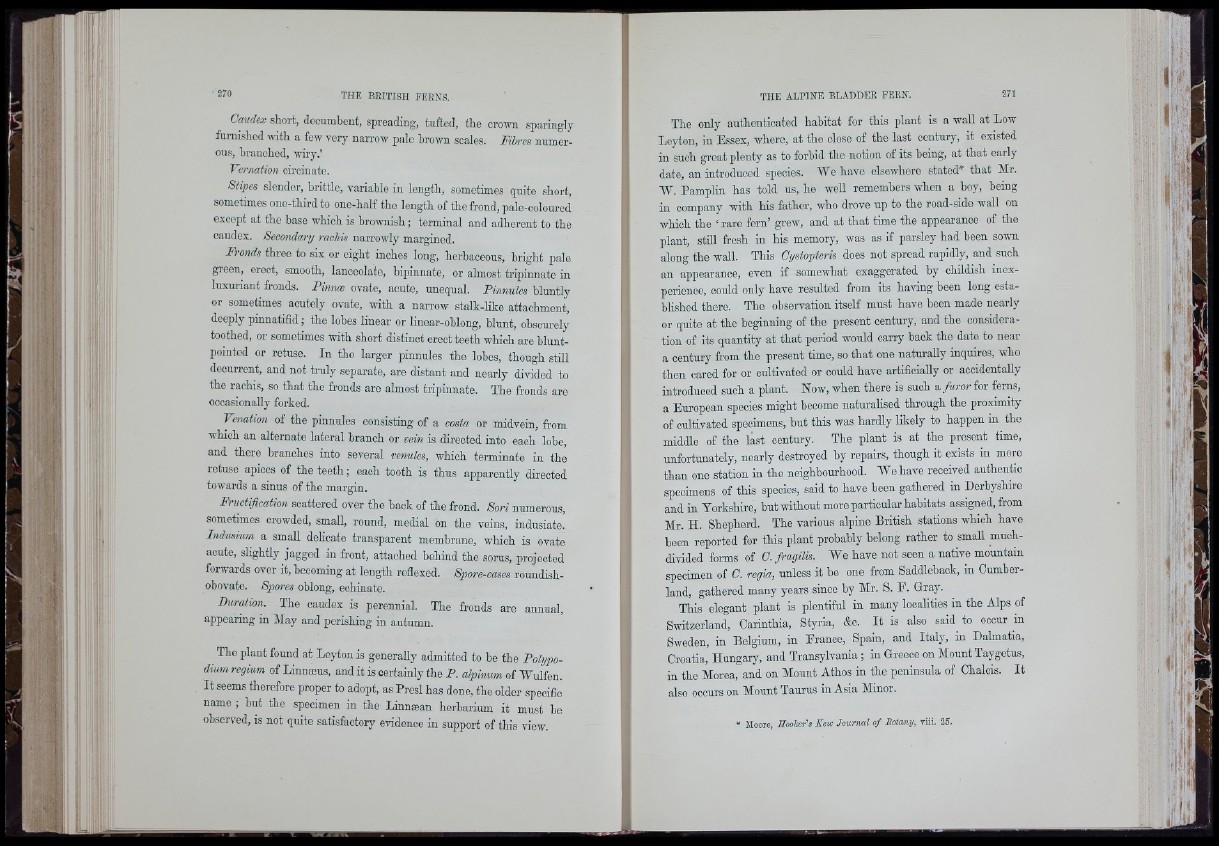
Caudex. short, docunihent, spreading, tufted, the crown sparingly
furnished with a few very narrow palo brown scales. Fibres numerous,
branched, -wiry.'
Vernation ciroinato.
Stipes slender, brittle, variable iu length, sometimes quite short,
sometimes one-third to ono-half the length of tho frond, pale-coloured
except at tho base which is brownish; terminal and adherent to the
caudox. Secondary rachis narrowly margined.
Fronds three to six or eight inches long, herbaceous, bright pale
green, erect, smooth, lanceolate, bipinnate, or almost tripinnate in
luxuriant fronds. Pinno! ovate, acute, unequal. Pinnules bluntly
or sometimes acutely ovate, with a narrow stalk-like attachment,
deeply pinnatifid; the lohes linear or linear-oblong, blunt, obscurely
toothed, or sometimes with short distinct erect teeth which are blunt-
pomted or retuse. In the larger pinnules the lobes, though still
decurrent, and not truly separate, are distant and nearly divided to
the raohis, so that the fronds are almost tripinnate. The fronds are
occasionally forked.
Venation of the pinnules consisting of a costa or midvem, from
which an alternate lateral branch or vein is directed into each lobe,
and there branches into several venules, which terminate in the
retuse apices of the teeth; each tooth is thus apparently directed
towards a sinus of the margin.
Fructification scattered over the back of the frond. Sori nnmerous,
sometimes crowded, small, round, medial on the veins, indusiate.
Indusium a small delicate transparent membrane, which is ovate
acute, slightly jagged in front, attached behind the sorus, projected
forwards over it, beooming at length reflexed. Spore-cases roundish-
obovate. Spores oblong, echinate.
Buration. The caudex is perennial. The fronds are annual,
appearing in May and perishing in autumn.
The plant found at Leyton is generally admitted to be the Polypo-
dium regium of Linnaeus, and it is certainly the P. alpinum of Wulfen.
It seems therefore proper to adopt, as Presl has done, the older specific
name ; hut the specimen in the Linnaean herbarium it must he
observed, is not quite satisfactory evidence in support of this view.
The only authenticated habitat for this plant is a wall at Low
Leyton, in Essex, where, at the close of the last century, it existed
in such great plenty as to forbid the notion of its heing, at that early
date, an introduood species. We have elsewhere stated* that Mr.
W. Pamplin has told us, ho woll remembers when a hoy, being
in company with his father, ivho drove up to the road-side wall on
which the ‘ rare fern’ grew, and at that time the appearance of the
plant, still fresh in his memory, was as if parsley had been soivn
along the wall. This Cystopteris does not spread rapidly, and such
an appearance, even if somewhat exaggerated hy childish inexperience,
could only have resulted from its having been long established
there. The observation itself must have been made nearly
or quite at the beginning of the present century, and the consideration
of its quantity at that period would carry hack the date to near
a century from tho present time, so that one naturally inquires, who
then cared for or cultivated or could have artificially or accidentally
introduced such a plant. Now, when there is such a furor for ferns,
a European species might become naturalised through the proximity
of cultivated specimens, hut this was hardly likely to happen in the
middle of the last century. The plant is at the present time,
unfortunately, nearly destroyed hy repairs, though it exists in more
than one station in the neighbourhood. We have received authentic
specimens of tHs species, said to have been gathered in Derbyshire
and in Yorkshire, hut without more particular habitats assigned, from
Mr. H. Shepherd. The various alpine British stations which have
been reported for tHs plant probably belong rather to small much-
divided forms of C. fragilis. We have not seen a native mountain
specimen of C. regia, unless it be one from Saddleback, in Cumberland,
gathered many years since by Mr. S. F. Gray.
This elegant plant is plentiful in many localities in the Alps of
Switzerland, Carinthia, Styria, &c. It is also said to occur in
Sweden, in Belgium, in France, Spain, and Italy, in Dalmatia,
Croatia, Hungary, and Transylvania; in Greece on Mount Taygetus,
in the Morea, and on Mount Athos in the peninsula of Chalois. It
also occurs on Mount Taurus in Asia Minor.
» Moore, Hooker's Row Journal o f Botany, riii. 25.
If
1 ' f l
fil